JAVA基础实验
JAVA实验内容

《JA V A编程语言》课程实验(一)要求完成的实验项目实验项目11、实验项目名称:JA VA语言面向对象基础实验2. 实验项目的目的和任务目的:(1)通过编程和上机实验了解JAVA语言基础知识,循环、分支语句的使用、数组的使用。
(2)通过编程和上机实验理解JAVA语言中的面向对象编程思想。
了解类与对象的创建,了解成员变量和成员方法的特性,构造函数的使用,类的继承机制和原理,方法的重载和覆盖多态,接口的实现,充分掌握JAVA面向对象编程方法。
任务:使用JA VA语言编写面向对象程序。
3. 实验内容:(1)编写一个矩阵操作类库,具体实现要求如下:●实现构造函数动态创建不同大小的二维矩阵m*n;●实现函数完成两个矩阵的相加、求差与矩阵各个元素相乘运算;●实现函数可以得到矩阵中指定元素数值。
(2)定义两个接口,其方法分别完成两个数的加法和减法操作,然后创建一个类实现这两个接口方法。
(3)用面向对象方法实现一个异质链表。
所谓异质是指链表中各个表项内容的类型要求不相同。
以大学环境为例,这里包括学生、职员和教授。
希望对这些人的信息进行管理(所有的人员信息记录在一个链表中)。
●学生(student):姓名、年龄、年级和平均成绩。
●职员(employer):姓名、年龄和小时工资。
●教授(professor):姓名、年龄和年工资。
要求实现以下四个操作:●插入。
制链表中增加一个学生、职员或教授的信息。
●删除。
从异质链表中删除一个学生、职员和教授的信息。
●能修改学生、职员或教授的个人信息。
●打印。
显示链表中所有的信息。
4.学时数:4实验项目21、实验项目名称:Java多线程、网络基础编程实验2、实验项目的目的和任务:目的:(1)通过继承线程类ng.Thread创建具有特定功能的线程类,通过实现接口ng.Runnable创建可作为线程运行的类,创建线程类对象,启动线程,并观察运行、停止。
创建实现了Runnable接口的线程类对象以后,启动线程,通过观察运行和停止,掌握线程类ng.Thread常用方法的使用,掌握对线程执行过程中的异常的处理方法。
大一学生java上机实验报告

大一学生java上机实验报告大一学生Java上机实验报告实验名称:Java基础语法练习实验目的:通过完成一系列Java基础语法的练习,熟悉Java 的语法规则和基本操作,加深对Java编程的理解。
实验内容及步骤:1. 编写一个Java程序,实现计算器功能。
该程序需要接收用户输入的两个数字和一个运算符,然后根据运算符的不同进行相应的运算,并将结果输出。
代码示例:```javaimport java.util.Scanner;public class Calculator {public static void main(String[] args) {Scanner scanner = new Scanner(System.in);System.out.print("请输入第一个数字:");double num1 = scanner.nextDouble();System.out.print("请输入第二个数字:");double num2 = scanner.nextDouble();System.out.print("请输入运算符(+、-、*、/):");String operator = scanner.next();double result = 0;switch (operator) {case "+":result = num1 + num2;break;case "-":result = num1 - num2;break;case "*":result = num1 * num2;break;case "/":result = num1 / num2;break;default:System.out.println("输入的运算符无效!");return;}System.out.println("计算结果为:" + result);}}```2. 编写一个Java程序,实现2到100之间的所有素数的查找和输出。
java基础入门实验报告
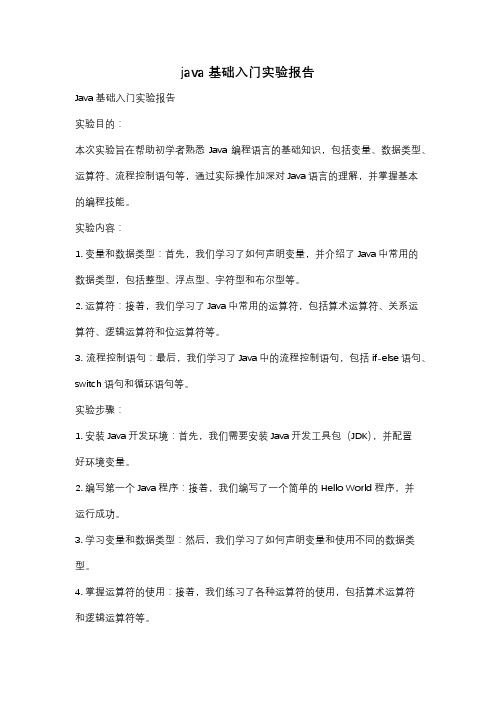
java基础入门实验报告Java基础入门实验报告实验目的:本次实验旨在帮助初学者熟悉Java编程语言的基础知识,包括变量、数据类型、运算符、流程控制语句等,通过实际操作加深对Java语言的理解,并掌握基本的编程技能。
实验内容:1. 变量和数据类型:首先,我们学习了如何声明变量,并介绍了Java中常用的数据类型,包括整型、浮点型、字符型和布尔型等。
2. 运算符:接着,我们学习了Java中常用的运算符,包括算术运算符、关系运算符、逻辑运算符和位运算符等。
3. 流程控制语句:最后,我们学习了Java中的流程控制语句,包括if-else语句、switch语句和循环语句等。
实验步骤:1. 安装Java开发环境:首先,我们需要安装Java开发工具包(JDK),并配置好环境变量。
2. 编写第一个Java程序:接着,我们编写了一个简单的Hello World程序,并运行成功。
3. 学习变量和数据类型:然后,我们学习了如何声明变量和使用不同的数据类型。
4. 掌握运算符的使用:接着,我们练习了各种运算符的使用,包括算术运算符和逻辑运算符等。
5. 学习流程控制语句:最后,我们学习了if-else语句和for循环语句的使用,并编写了一些简单的程序进行练习。
实验结果:通过本次实验,我们成功地掌握了Java编程语言的基础知识,包括变量、数据类型、运算符和流程控制语句等,并且能够编写简单的Java程序。
同时,我们也对Java开发环境有了更深入的了解,为以后的学习打下了良好的基础。
结论:本次实验是我们学习Java编程语言的第一步,虽然只是入门级别的内容,但对于初学者来说却是非常重要的。
通过实际操作,我们不仅加深了对Java语言的理解,也掌握了基本的编程技能,为以后的学习打下了坚实的基础。
希望在以后的学习中能够不断提升自己的编程能力,更好地应用Java语言进行开发。
java基础实验报告

java基础实验报告Java基础实验报告引言:Java作为一种面向对象的编程语言,广泛应用于软件开发领域。
本次实验旨在通过一系列的实验任务,加深对Java基础知识的理解,并掌握Java编程的基本技巧。
实验一:Java环境搭建在本实验中,我们首先需要搭建Java开发环境。
Java开发工具包(JDK)是进行Java编程的基础,我们可以从Oracle官网上下载并安装最新版本的JDK。
安装完成后,我们需要配置环境变量,以便在命令行中能够直接运行Java相关的命令。
实验二:Java语言基础Java语言基础是进行Java编程的基石。
在本实验中,我们需要掌握Java的基本语法规则、数据类型和运算符等。
通过编写简单的程序,如计算两个数的和、判断一个数是否为素数等,加深对Java语言基础的理解。
实验三:面向对象编程面向对象编程是Java的核心特性之一。
在本实验中,我们需要学习Java中的类和对象的概念,并通过编写简单的类和对象来实现一些功能。
例如,创建一个学生类,包含姓名、年龄和成绩等属性,并实现一些与学生相关的操作方法。
实验四:异常处理异常处理是Java编程中重要的一部分。
在本实验中,我们需要学习Java中的异常处理机制,并通过编写代码来处理可能出现的异常情况。
例如,通过try-catch语句来捕获并处理用户输入非法字符的异常。
实验五:文件操作在实际的软件开发中,文件操作是非常常见的需求。
在本实验中,我们需要学习Java中的文件操作相关的类和方法,并通过编写代码来实现文件的读取和写入等功能。
例如,读取一个文本文件中的内容,并将其写入到另一个文件中。
实验六:多线程编程多线程编程是提高程序性能和效率的一种方式。
在本实验中,我们需要学习Java中的多线程编程相关的知识,并通过编写代码来实现多线程的应用。
例如,创建多个线程来同时下载多个文件,并实现进度条的显示。
结论:通过完成以上一系列的实验任务,我们对Java基础知识有了更深入的理解,并掌握了Java编程的基本技巧。
java编程实验报告
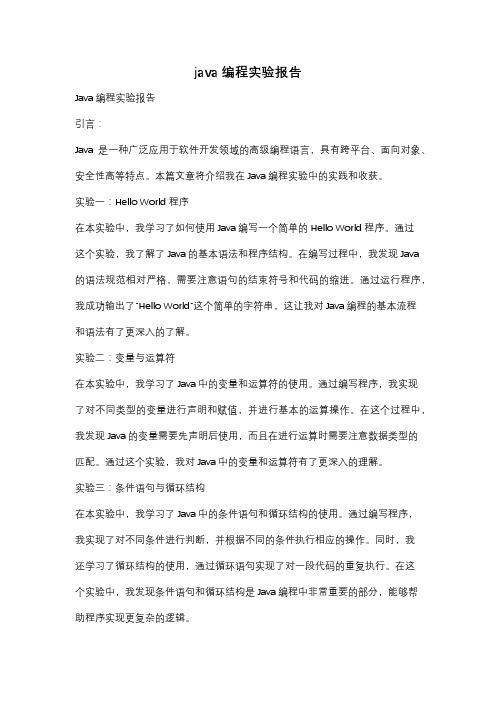
java编程实验报告Java编程实验报告引言:Java是一种广泛应用于软件开发领域的高级编程语言,具有跨平台、面向对象、安全性高等特点。
本篇文章将介绍我在Java编程实验中的实践和收获。
实验一:Hello World程序在本实验中,我学习了如何使用Java编写一个简单的Hello World程序。
通过这个实验,我了解了Java的基本语法和程序结构。
在编写过程中,我发现Java的语法规范相对严格,需要注意语句的结束符号和代码的缩进。
通过运行程序,我成功输出了"Hello World"这个简单的字符串,这让我对Java编程的基本流程和语法有了更深入的了解。
实验二:变量与运算符在本实验中,我学习了Java中的变量和运算符的使用。
通过编写程序,我实现了对不同类型的变量进行声明和赋值,并进行基本的运算操作。
在这个过程中,我发现Java的变量需要先声明后使用,而且在进行运算时需要注意数据类型的匹配。
通过这个实验,我对Java中的变量和运算符有了更深入的理解。
实验三:条件语句与循环结构在本实验中,我学习了Java中的条件语句和循环结构的使用。
通过编写程序,我实现了对不同条件进行判断,并根据不同的条件执行相应的操作。
同时,我还学习了循环结构的使用,通过循环语句实现了对一段代码的重复执行。
在这个实验中,我发现条件语句和循环结构是Java编程中非常重要的部分,能够帮助程序实现更复杂的逻辑。
实验四:数组和字符串在本实验中,我学习了Java中数组和字符串的使用。
通过编写程序,我实现了对数组和字符串的声明、赋值和操作。
在这个过程中,我发现Java中的数组和字符串是一种非常方便的数据结构,能够帮助程序处理大量的数据。
通过这个实验,我对Java中数组和字符串的使用有了更深入的了解。
实验五:面向对象编程在本实验中,我学习了Java中的面向对象编程的基本概念和使用。
通过编写程序,我实现了对类的定义、对象的创建和方法的调用。
java编程基础实验报告

Java编程基础实验报告1. 引言本实验报告旨在介绍Java编程基础实验的步骤和相关思考过程。
通过本实验,我深入了解了Java编程语言的基本概念和语法,并通过实际编程练习提高了我的编程技巧。
2. 实验目的本次实验的目的是通过编写Java程序来实现一些基本的编程任务,包括变量的声明与使用、条件分支、循环结构、函数定义和调用等。
通过这些任务的完成,我可以加深对Java编程的理解和掌握。
3. 实验环境在本次实验中,我使用了以下工具和环境: - Java Development Kit (JDK) - 集成开发环境(IDE):我选择使用IntelliJ IDEA4. 实验步骤步骤一:环境搭建首先,我下载并安装了Java Development Kit (JDK)。
然后,我安装了IntelliJ IDEA作为我的集成开发环境。
步骤二:创建Java项目在IntelliJ IDEA中,我创建了一个新的Java项目。
我选择了一个合适的项目名称,并选择了项目的存储路径。
步骤三:编写Java代码在项目中,我创建了一个Java源代码文件,并开始编写Java程序。
根据实验要求,我定义了必要的变量,并使用条件分支和循环结构来实现程序的逻辑。
步骤四:调试和运行程序在编写完Java代码后,我使用IntelliJ IDEA提供的调试功能来检查代码中的错误。
我逐行运行程序,并观察变量的值和程序的输出,以确保代码的正确性。
步骤五:实验总结在实验过程中,我遇到了一些困难和问题。
通过阅读相关的教程和文档,我解决了这些问题,并加深了对Java编程语言的理解。
5. 实验结果通过本次实验,我成功地实现了实验要求中的Java程序。
我观察到程序输出了预期的结果,并且在调试过程中没有发现任何错误。
6. 实验心得通过参与这次Java编程基础实验,我对Java编程语言有了更深入的了解。
我学会了如何使用Java变量、条件分支、循环结构和函数定义等基本概念。
java实验实验报告

java实验实验报告Java 实验实验报告一、实验目的本次 Java 实验的主要目的是通过实际操作和编程实践,深入理解和掌握 Java 编程语言的基本概念、语法结构、面向对象编程的思想以及常用类库的使用。
同时,培养我们解决实际问题的能力和编程思维,提高代码的质量和可读性。
二、实验环境1、操作系统:Windows 102、开发工具:IntelliJ IDEA3、 JDK 版本:18三、实验内容(一)基本语法练习1、数据类型与变量在 Java 中,我们学习了不同的数据类型,如整数类型(`int`、`long`)、浮点数类型(`float`、`double`)、字符类型(`char`)和布尔类型(`boolean`)。
通过定义和使用这些变量,我们能够存储和操作各种类型的数据。
```javaint age = 25;double salary = 500050;char grade ='A';boolean isStudent = true;```2、控制结构包括条件语句(`ifelse`、`switch`)和循环语句(`for`、`while`、`dowhile`)。
这些控制结构使我们能够根据不同的条件执行不同的代码块,或者重复执行一段代码。
```javaint num = 10;if (num > 5) {Systemoutprintln("Number is greater than 5");} else {Systemoutprintln("Number is less than or equal to 5");}switch (num) {Systemoutprintln("One");break;case 10:Systemoutprintln("Ten");break;default:Systemoutprintln("Unknown");}for (int i = 0; i < 5; i++){Systemoutprintln(i);}int count = 0;while (count < 3) {Systemoutprintln("Count: "+ count);count++;}count = 0;Systemoutprintln("Count: "+ count);count++;} while (count < 3);```(二)面向对象编程1、类与对象创建了自定义的类来表示现实世界中的实体。
Java基础编程实验报告

实验报告课程名称Java程序设计实验项目实验一Java基础编程系别____计算机学院_________专业/班级__________姓名_______________实验日期_______________________成绩_______________________指导教师一、实验题目:实验一Java基础编程二、实验内容:(1)创建一个Java Application程序,实.现流式交互输入输出要求:从键盘输入自己的姓名,学号,专业在屏幕上输出:“姓名:,学号:,专业:”(2)创建一个Java Application程序,编写输出乘法口诀表的程序1*1=11*2=2 2*2=41*3=3 2*3=6 3*3=91*4=4 2*4=8 3*4=12 4*4=16。
(3)计算销售额假设在地产公司的收入包括基本工资和提成,基本工资是2000元,提成率的计算方式如下:销售额提成率0.01-5000 8%5000.01-10000 10%>10000.01 12%要求:从屏幕输入一年的预期收入(例如60000元),求出达到该目标所必须完成的最小销售额(4)选作:输出某个特定时间的日历页要求:从屏幕输入某个特定的时间,例如:2006-12-1,编写程序,在屏幕上以日历页的方式显示该时间,如下图所示。
提示:1)接收输入时间时,是单个时间,需要进行字符串分析,找到相应的年、月、日,因此可能要使用StringTokenizer类来为字符串构造分析器。
2)注意在创建Calendar对象时,设置的参数与实际时间之间的关系。
三、程序清单及结果:(需要标明实现程序对应的实验内容,并给出合理的程序注释及运行结果)实验(1)import java.util.*;public class InputTest {public static void main(String[] args){Scanner in =new Scanner(System.in);//构造Scanner对象,并与“标准输入流”System.in关联System.out.print("学生姓名,学号,专业");String name =in.next();//输入学生姓名int num =in.nextInt();//输入学号String major =in.next();//输入专业System.out.println("学生姓名:"+name+"学号:"+num+"专业:"+major);//输出学生姓名,学号,专业}}程序运行结果实验(二)public class wangyao{ public static void main(String args[]){int a,b,c;//定义整型变量a,b,cfor(a=1;a<=9;a++){for(b=1;b<=a;b++){c=a*b;//计算a*b的制,把制赋给cSystem.out.println(b+"*"+a+"="+c);//输出乘法式子}System.out.println("\n");//每进行完一次换行}}}实验(三)import java.util.*;public class InputTest{public static void main(String[] args){Scanner in = new Scanner(System.in);//构造Scanner对象,并与“标准输入流”System.in关联double a,b;//定义两个双精度浮点型变量a,bb=0.0;//初始化bSystem.out.print("请输入一年的预期收入");a=in.nextDouble();//从键盘输入aif(a<=28800)b=(a/12-2000)/0.08;if(a>28800&&a<=34800)b=((a/12-2000-400)/0.1)+5000.01;if(a>34800)b=((a/12-2000-400-500)/0.12)+10000.01;System.out.println("每月最小销售额是"+b);//输出每月最小销售额}}四、程序调试报告及总结在做第一个实验的时候,把System.out.println("学生姓名:"+name+"学号:"+num+"专业:"+major);的println写出print,导致不能输出。
java 实验报告

java 实验报告Java 实验报告引言:Java 是一种广泛应用于软件开发的计算机编程语言,具有跨平台、面向对象、简单易学等特点。
本实验报告将介绍我在学习 Java 过程中进行的一系列实验,包括实验目的、实验过程、实验结果和实验总结。
实验一:Hello World 程序实验目的:通过编写一个简单的 Hello World 程序,熟悉 Java 的开发环境和基本语法。
实验过程:1. 安装 Java Development Kit(JDK)并配置环境变量。
2. 使用文本编辑器编写以下代码:```javapublic class HelloWorld {public static void main(String[] args) {System.out.println("Hello, World!");}}```3. 将代码保存为 HelloWorld.java。
4. 打开命令提示符,切换到代码所在目录,输入以下命令编译代码:```javac HelloWorld.java```5. 输入以下命令运行程序:```java HelloWorld```实验结果:命令提示符中输出 "Hello, World!"。
实验二:数据类型和运算符实验目的:了解 Java 的数据类型和运算符,并能够正确使用它们进行计算。
实验过程:1. 声明并初始化不同类型的变量,例如整数、浮点数和布尔类型。
2. 使用算术运算符进行基本的数值计算。
3. 使用逻辑运算符进行布尔类型的操作。
实验结果:根据实验过程中的代码和输入,得到相应的计算结果。
实验三:条件语句和循环结构实验目的:掌握 Java 中的条件语句和循环结构,能够根据不同的条件执行相应的代码块。
实验过程:1. 使用 if-else 语句实现条件判断。
2. 使用 switch-case 语句实现多分支选择。
3. 使用 for 循环、while 循环和 do-while 循环实现不同的循环结构。
Java编程基础实验报告

Java编程基础实验报告编制教师审定2010至2011学年第一学期计算机科学学院实验名称:Java开发工具与简单Java程序设计指导教师:实验仪器:计算机实验日期:年月日实验地点:五教北503 成绩:实验目的:(1)熟悉JDK开发环境。
(2)掌握Java Application的程序结构和开发过程。
(3)了解Java Applet的功能与程序结构。
实验内容及基本要求:1、运行下列程序,写出其输出结果。
public class Hello{public static void main(String args[]){System.out.println(“你好,很高兴学习Java”);}}2、运行下列程序,写出其输出结果。
import java.applet.*;import java.awt.*;public class boy extends Applet{public void paint(Graphics g){g.setColor(Color.red);g.drawString(“Java是跨平台的语言,一次编译,到处运行。
”,2,30);g.setColor(Color.blue);g.drawString(“我学得很认真”,10,50);}}3、分别用应用程序和小应用程序编程,要求输出字符串“我喜欢学习Java。
”实验过程及结果:实验总结:实验评价(教师):实验名称:Java语言基础指导教师:实验仪器:计算机实验日期:年月日实验地点:五教北503 成绩:实验目的:(1)掌握标识符的定义规则。
(2)掌握各种基本数据类型及其相互转换。
(3)掌握各种运算符的实验及其优先级控制。
(4)掌握JAVA的控制语句和循环语句。
实验内容及基本要求:l、上机运行下列程序,写出其输出结果。
public class Convert{public static void main(String args[]){byte a=120; short b=255;int c=2200; long d=8000;float f;double g=123456789.123456789;b=a;c=(int)d;f=(float)g;System.out.print(“a=”+a); System.out.println(“b=”+b);System.out.print(“c=”+c); System.out.println(“d=”+d);System.out.print(“f=”+f); System.out.println(“g=”+g);2、上机运行下列程序,写出其输出结果。
Java程序基础实验报告
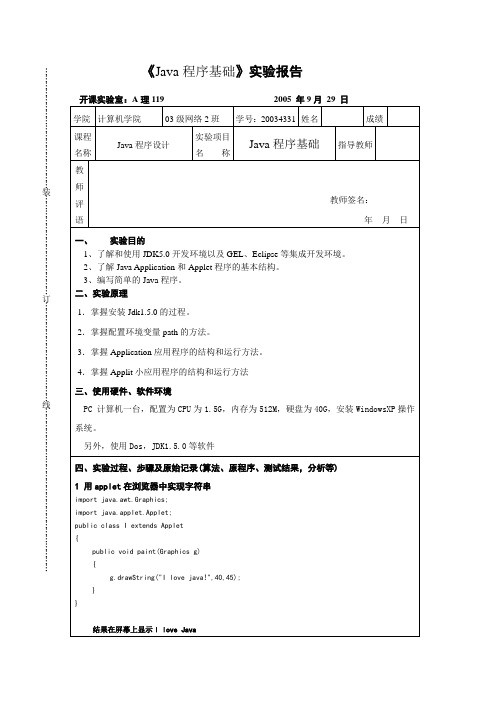
{
for(int j=0;j<myArray[0].length;j++)
{
maxList[j]=myArray[i][j];
}
int max=MyMax(maxList)[0];
for(int j=0;j<myArray.length;j++)
for(int i=1;i<list.length;i++)
{
if((list[i]>max))
{Leabharlann max=list[i];arrayList[1]=i;
}
}
arrayList[0]=max;
return arrayList;
}
private static int MyMin(int[] list)
{
2、加深了Java中相关语法的认识:
在初次录入源程序时,我将public写成了Public,导致编译出错,结合语法我认识到Java是严格区分大小写的;
Java中的主类名应与源程序文件名是一致的;
Java Applet中主类应有public修饰,而在最初设计时,我没有写入该修饰关键字。
Java Applet没有独立的运行环境,需要在IE浏览器中或在JDK的appletviewer中方可运行。如果在IE浏览器中运行,则应在<applet>标签中将code属性指向我们所编译的类名。
int[][] myArray={
{12,13,8,423,18,433}
,{0,36,20,723,123,2301}
,{42,564,433,56,1,5000}};
实验二Java基础

一、实验目的
1)掌握java语言的各种数据类型
2)熟悉运算符和表达式
3)学会编写简单程序
二、实验内容
1)下面是一个简单的Java程序,将多种类型变量通过各种运算符组成不同的表达式,并将运算结果赋值给同类型的变量,使用println()方法输出各变量的值。
publicclassExampleTest {
E:定义一个字节变量,并初始化,0x10是十六进制数,对应的十进制数为16,故bValue的值为16。
F:no和bValue进行比较,比较的结果为布尔型,结果赋给bool,no比bValue大,故结果为true。
运行结果:
2)为了使程序易懂,在程序中添加适当的注释;为了使程序输出结果清晰明了,应该输出相应的提示性信息;上机编译并运行该程序。
三、实验要求
1)分析程序中A行~F行各运算符的作用、表达式的功能和表达式的值,并和程序输出结果比较。
A:计算int变量no的值,并将运算结果赋给no。no的值为18。
B:自增运算,no的值增加1,此时no的值变为19。
C:定义一个布尔变量bool,并初始化为false。
D:将右边的式子进行逻辑运算,!的优先级较高,故先运算!bool再与true相与,结果为true。
2)编写一个Java程序,计算一个半径为3.0的圆的周长和面积并输出他们的计算结果。
3)编写一个Java程序,计算一个给定底和高的的直角三角形的斜边长。
注:直角三角形的斜边长length=Math.sqrt(base*base+height*height);
其中base和height为两条直角边的边长。
程序:
运行结果:
3)首先将变量base、height、length都定义为double型,编译并运行程序;将length类型更改为float型后(其他保持不变),在编译该程序,观察会出现什么结果并分析原因。
Java语言基础实验

实验一 Java语言基础【实验目的】(1)掌握下载Java SDK 软件包、学会设置Java环境变量。
掌握在Dos环境下Java应用程序和Java Applet程序的编译和运行的方法。
(2)掌握MyEclipse /JBuilder集成开发工具的使用方法。
(3)了解和掌握Java的基本数据类型;(4)熟练了解Java语言的标准输入和输出;(5)了解和运用Javax.swing.JOptionPane类实现数据的输入和输出。
(6)熟练掌握和运用数组来解决实际问题。
(7)了解和运用String类,熟悉String类的构造方法。
【实验任务】本实验由4个练习构成。
练习1:用记事本编写编写一个简单的应用程序,该程序在命令行窗口输出两行文字:“你好,很高兴学习Java”和“We are students”。
练习2:用记事本编写一个简单的Java Applet程序,并在Java Applet中写两行文字:“这是一个Java Applet程序”和“我改变了字体”。
练习3:在控制台下求两个实数的最大值问题。
通过该程序了解类System在数据输入和输出中所起的作用,以及Scanner的作用。
练习4:回文数。
编写一个Java程序。
用户从键盘输入一个1~9999之间的数,程序将判断这个数是几位数,并判断是否是回文数。
回文数是指将该数含有的数字逆序排列后得到的数和原数相同,例如12121、3223都是回文数。
练习5:猜数字游戏。
编写一个程序,实现下列功能:程序随机分配给客户一个1~100之间的整数,用户在输入对话框中输入自己的猜测。
程序返回提示信息,提示信息分别是:“猜大了”、“猜小了”和“猜对了”。
练习6:从键盘任意输入10个数字,对这些数字用直接插入排序的方法进行排序,排序后将10个数字按从小到大的顺序排列显示出来。
练习7:String类的常用方法。
编写一个Java应用程序,判断两个字符串是否相等,判断字符串的前缀、后缀是否和某个字符串相同,按字典顺序比较两个字符串的大小关系,检索字符串,创建子字符串,将数字型字符串转换为数字,将字符串放到数组中,用字符数组创建字符串。
Java编程基础实验报告

Java编程基础实验报告编制教师唐春兰审定代伟(适用于计算机科学学院专业学生)专业: 物联网工程班级: 2015 级 4 班学号: 20151044018_ __ 姓名: 刘星_ _2016至2017学年第一学期计算机科学学院实验名称:Java 语言基础指导教师:唐春兰实验仪器:计算机实验日期:2016 年12 月2 日实验地点:第三实验楼209实验目的:1、了解Java 的数据类型;2、掌握各种变量的声明方式;3、理解运算符的优先级;4、掌握JAVA基本数据类型、运算符与表达式、数组的使用方法;5、理解JAVA程序语法结构,掌握顺序结构、选择结构和循环结构语法的程序设计方法;6、通过以上内容,掌握JAVA语言的编程规则。
实验内容及基本要求:1、读下列程序,理解不同数据类型变量的声明,写出其输出结果并上机运行验证。
public class SHIYAN2_1 {public static void main(String[] args) {byte b=0x55;short s=0x55ff;int i=1000000;long l=0xffffL;char c='a';float f=0.23F;double d=0.7E-3;boolean B=true;String S=" 这是字符串类数据类型 ";System.out.println(" 字节型变量 b = "+b);System.out.println(" 短整型变量 s = "+s);System.out.println(" 整型变量 i = "+i);System.out.println(" 长整型变量 l = "+l);System.out.println(" 字符型变量 c = "+c);System.out.println(" 浮点型变量 f = "+f);System.out.println(" 双精度变量 d = "+d);System.out.println(" 布尔型变量 B = "+B); System.out.println(" 字符串类对象 S = "+S);}}2、分析下列程序,了解变量的使用范围,修改程序使之能成功运行public class SHIYAN2_2 {int i=10;public static void main(String[] args){int k=10;System.out.println("i="+i);System.out.println("k="+k); }System.out.println("i="+i);System.out.println("k="+k);}}3、分析下列程序,并输出结果。
java基础语法实验实验原理

java基础语法实验实验原理
Java基础语法实验原理
Java基础语法实验是一种通过编写和运行Java程序来理解和掌握Java语言基
础知识和语法规则的实践活动。
这些实验旨在帮助学习者熟悉Java编程环境以及Java程序的结构、语法和执行过程。
在进行Java基础语法实验时,首先需要安装Java开发工具包(JDK)并配置
好Java开发环境。
然后,使用任何文本编辑器编写Java源代码文件,以.java为后
缀名保存。
Java程序员使用Java编译器(javac)将源代码编译为Java字节码文件(.class文件)。
Java程序的执行依赖Java虚拟机(JVM)。
通过调用Java虚拟机内的Java解
释器(java),可以在计算机上执行Java程序。
Java虚拟机会读取并解释Java字
节码文件,将其转换为可执行的机器码。
这样,Java程序就可以在不同的操作系统上运行。
在进行Java实验时,学习者可以编写简单的程序,例如输出"Hello World"的程序。
这样的程序可以帮助学习者了解Java语法中的基本元素,如变量声明、数据
类型、运算符和控制语句等。
此外,Java实验也可以涉及更复杂的概念和功能,如面向对象编程、异常处理、文件操作和多线程等。
通过逐步增加难度和复杂度,学习者可以逐渐提高自己的Java编程技能和理解能力。
总之,Java基础语法实验通过实践操作帮助学习者掌握Java编程的基本原理和规则。
通过不断地编写和运行Java程序,学习者可以加深对Java语言的理解,并
逐步提升自己的编程能力。
JAVA实验报告
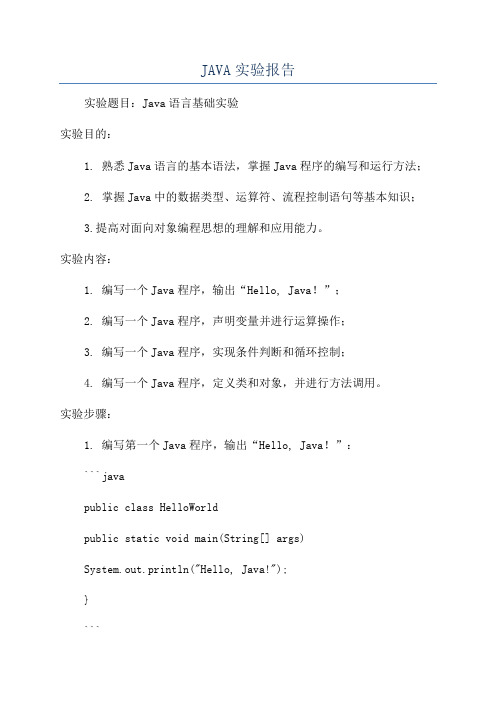
JAVA实验报告实验题目:Java语言基础实验实验目的:1. 熟悉Java语言的基本语法,掌握Java程序的编写和运行方法;2. 掌握Java中的数据类型、运算符、流程控制语句等基本知识;3.提高对面向对象编程思想的理解和应用能力。
实验内容:1. 编写一个Java程序,输出“Hello, Java!”;2. 编写一个Java程序,声明变量并进行运算操作;3. 编写一个Java程序,实现条件判断和循环控制;4. 编写一个Java程序,定义类和对象,并进行方法调用。
实验步骤:1. 编写第一个Java程序,输出“Hello, Java!”:```javapublic class HelloWorldpublic static void main(String[] args)System.out.println("Hello, Java!");}```2. 编写第二个Java程序,声明变量并进行运算操作:```javapublic class Calculationpublic static void main(String[] args)int a = 10;int b = 5;int sum = a + b;int difference = a - b;int product = a * b;double quotient = (double) a / b;System.out.println("Sum: " + sum);System.out.println("Difference: " + difference); System.out.println("Product: " + product); System.out.println("Quotient: " + quotient);}```3. 编写第三个Java程序,实现条件判断和循环控制:```javapublic class Conditionalpublic static void main(String[] args)int num = 10;if (num > 0)System.out.println("Positive number");} else if (num < 0)System.out.println("Negative number");} elseSystem.out.println("Zero");}for (int i = 1; i <= 5; i++)System.out.println("Count: " + i);}}```4. 编写第四个Java程序,定义类和对象,并进行方法调用:```javapublic class PersonString name;int age;public void introducSystem.out.println("Name: " + name);System.out.println("Age: " + age);}public static void main(String[] args)Person person1 = new Person(; = "Alice";person1.age = 25;person1.introduce(;Person person2 = new Person(; = "Bob";person2.age = 30;person2.introduce(;}```实验结论:通过本次实验,我进一步熟悉了Java语言的基本语法和编程思想,掌握了Java程序的编写和运行方法。
java入门级实验指导(15个实验)

目录实验1: JDK开发工具 (3)实验2: Java语言基础 (5)实验3:控制语句 (8)实验4:方法 (10)实验5:数组 (12)实验6:面向对象的程序设计 (14)实验7:字符串处理 (18)实验8:异常处理 (20)实验9:Java中的输入输出…………………………22实验10:多线程 (25)实验11:布局管理器的使用 (28)实验12:事件处理模式 (30)实验13: Swing组件 (32)实验14: Applet小程序使用………………………33实验15: Applet高级应用 (36)实验1: JDK开发工具一、实验目的1.熟悉JDK开发环境。
2.掌握Java Application的程序结构和开发过程。
3.掌握Java Applet的程序结构和开发过程。
二、实验内容1.JDK开发环境(1)JDK1.4.2开发环境安装在"C:\JDK1.4.2_05\"目录下。
(2)设置环境变量PATH和CLASSPATH(如果在autoexec.bat中没有进行设置)。
进入命令行(MS-DOS)方式,进行如下设置:SET PA TH=c:\jdk1.4.2_05\bin;%PATH%SET CLASSPATH=.; c:\jdk1.4.2_05\lib\dt.jar; c:\jdk1.4.2_05\lib\tools.jar 2.掌握Java Application程序开发过程(1)打开记事本(2)键入如下程序:import java.io.*;public class HelloWorld1{public static void main(String args[]){System.out.println("Hello World!");}}(3)检查无误后(注意大小写)保存文件。
可将文件保存在"D:\Java\"目录中,注意文件名为HelloWorld1.java。
实验2 Java编程基础

实验2 Java编程基础一、实验目的1.熟悉基本数据类型,包括其所占字节数、数值范围及常数的后缀形式;2.掌握变量的声明、初始化方法,能够正确区分全局变量(即成员变量)和局部变量(即本地变量);3.掌握关系运算符()、>=、<、<=、==、!=)和逻辑运算符(!、&&、||)的使用;4.熟悉Java程序的常用输入输出格式。
二、实验内容与步骤说明:①实验报告必须完成的是基础题,提交课外完成题及提高题的可以加分;②本实验的操作环境是:文本编辑器(如写字板等)、javac和java命令;③可先建立F:\myjava目录,再在其中建立java源程序,并编译、运行。
1.(基础题)应用程序若要输出如图2-1所示结果,请将程序所缺代码填充完整,并加以运行,然后完成实验报告相关内容:图2-1程序运行结果程序代码:________________ Diamond {_____________________ main(__________ args[]) {System.out.println(" *");System.out.println(" * *");System.out.println(" * *");System.out.println("* *");____________________________;____________________________;____________________________;}}2.(基础题)请按下列要求,将程序代码填充完整,并加以运行:public class Test {// 初始值为0的整型变量 b1// 初始值为10000的长整型变量b2// 初始值为3.4的浮点型变量b3// 初始值为34.45的双精度型变量b4// 初始值为’4’的字符型变量b5// 初始值为true的布尔型变量b6public static void main(String ________) {// 输出变量b1——b6的值}}3.(基础题)输入下列程序内容,运行程序,并回答相关问题:public class DataType {public static void main(String args[]) {byte a1 = 126, a2 = (byte) 256, a3 = 'A';System.out.println("a1=" + a1 + "\ta2=" + a2 + "\ta3=" + a3);int b1 = 12345, b2 = (int) 123456789000L, b3 = '0', b4 = 0xff;System.out.println("b1=" + b1 + "\tb2=" + b2 + "\tb3=" + b3 + "\tb4="+ b4);char c1 = 'a', c2 = 98, c3 = '\u0043', c4 = '\n';System.out.println("c1=" + c1 + "\tc2=" + c2 + c4 + "c3=" + c3);}}问题:(1)变量a2、a3的输出内容是什么?为何出现这种变化?(2)变量b2、b3的输出内容是什么?为何出现这种变化?(3) '\t'、'\n'各有什么特殊用途?(4)System.out的println()方法与print()方法有什么不同?(5)如何声明、初始化一个变量?(6)b4初始化时,被赋予什么进制的数?(7)写出声明ch为字符型变量、并初始化为'c'的三种不同写法。
java编程基础实验报告
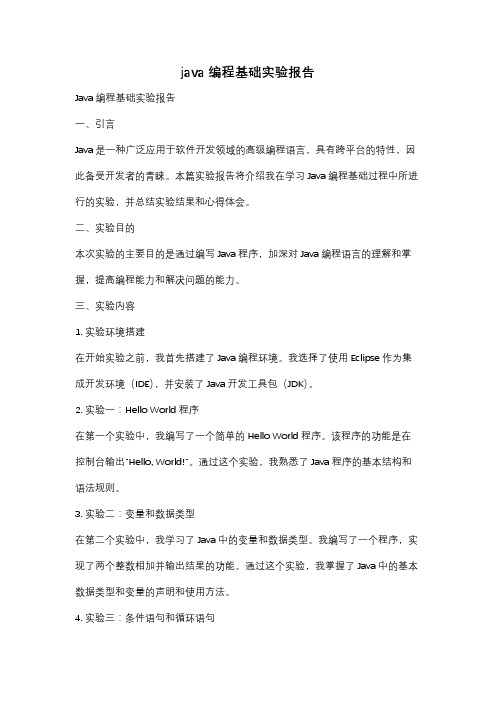
java编程基础实验报告Java编程基础实验报告一、引言Java是一种广泛应用于软件开发领域的高级编程语言,具有跨平台的特性,因此备受开发者的青睐。
本篇实验报告将介绍我在学习Java编程基础过程中所进行的实验,并总结实验结果和心得体会。
二、实验目的本次实验的主要目的是通过编写Java程序,加深对Java编程语言的理解和掌握,提高编程能力和解决问题的能力。
三、实验内容1. 实验环境搭建在开始实验之前,我首先搭建了Java编程环境。
我选择了使用Eclipse作为集成开发环境(IDE),并安装了Java开发工具包(JDK)。
2. 实验一:Hello World程序在第一个实验中,我编写了一个简单的Hello World程序。
该程序的功能是在控制台输出"Hello, World!"。
通过这个实验,我熟悉了Java程序的基本结构和语法规则。
3. 实验二:变量和数据类型在第二个实验中,我学习了Java中的变量和数据类型。
我编写了一个程序,实现了两个整数相加并输出结果的功能。
通过这个实验,我掌握了Java中的基本数据类型和变量的声明和使用方法。
4. 实验三:条件语句和循环语句在第三个实验中,我学习了Java中的条件语句和循环语句。
我编写了一个程序,实现了判断一个数是否为偶数并输出结果的功能。
通过这个实验,我掌握了Java中的if语句和for循环语句的使用方法。
5. 实验四:数组和字符串在第四个实验中,我学习了Java中的数组和字符串。
我编写了一个程序,实现了对一个整型数组进行排序并输出结果的功能。
通过这个实验,我掌握了Java中数组的声明和使用方法,以及字符串的操作方法。
6. 实验五:面向对象编程在第五个实验中,我学习了Java中的面向对象编程。
我编写了一个程序,实现了一个简单的学生信息管理系统。
通过这个实验,我掌握了Java中类的定义和对象的创建与使用方法。
四、实验结果通过以上实验,我成功编写了各种Java程序,并在控制台输出了预期的结果。
java语言基础实验总结

java语言基础实验总结Java语言是一种面向对象的编程语言,具有跨平台性和易学性的特点。
在学习Java语言的过程中,我们不仅需要掌握其基本语法和常用类库,还需要通过实验来巩固和应用所学知识。
本文将总结基于Java语言的实验经验,并提出一些实践中的注意事项。
Java语言的基础实验主要包括以下几个方面:控制语句、数组、字符串、面向对象等。
其中,控制语句实验主要涉及条件语句(if-else语句、switch语句)和循环语句(for循环、while循环、do-while循环),通过编写实例代码来熟悉和理解这些语句的使用方法和运行原理。
在进行数组实验时,我们可以学习如何声明和初始化数组,如何使用下标访问数组元素,以及如何利用循环结构对数组进行遍历和操作。
通过实验,我们可以加深对数组的理解,并能够熟练地处理数组相关的问题。
字符串实验主要涉及字符串的基本操作和常用方法,如字符串的连接、截取、查找和替换等。
通过实验,我们可以掌握字符串的常用操作技巧,提高字符串处理的效率和准确性。
面向对象实验是Java语言实验中的重点和难点,主要涉及类的定义、对象的创建和方法的调用等内容。
通过实验,我们可以更好地理解面向对象的概念和原则,并能够熟练地运用面向对象的思想解决实际问题。
在进行Java语言实验时,我们需要注意以下几点。
首先,要养成良好的编码习惯,包括规范的命名规则、适当的注释和清晰的代码结构。
其次,要注意代码的可读性和可维护性,避免出现冗长复杂的代码和不必要的重复操作。
此外,要注意代码的健壮性和容错性,合理处理异常情况,避免程序崩溃或产生错误结果。
在实验过程中,我们还可以通过调试和测试来验证代码的正确性和性能。
调试可以帮助我们找出代码中的错误和问题,测试可以帮助我们验证代码在不同情况下的运行结果。
通过反复调试和测试,我们可以逐步完善和优化代码,提高代码的质量和效率。
总的来说,Java语言基础实验是学习和掌握Java语言的重要方式之一。
- 1、下载文档前请自行甄别文档内容的完整性,平台不提供额外的编辑、内容补充、找答案等附加服务。
- 2、"仅部分预览"的文档,不可在线预览部分如存在完整性等问题,可反馈申请退款(可完整预览的文档不适用该条件!)。
- 3、如文档侵犯您的权益,请联系客服反馈,我们会尽快为您处理(人工客服工作时间:9:00-18:30)。
Q7. Input a particular year and month from your keyboard, and then output how many days this month has. The algorithm used in this experiment is also making choices.Take there are about 30 days in a month into consideration, we can use switch here. package java_Daysjudge; import java.util.Scanner; public class Days_judge { public static void main(String[] args) { int days=0;
System.arraycopy(X, 1, W, 2, 4); System.out.println("复制的数组W:" + Arrays.toString(W)); // binarySearch方法返回某个元素在数组中的位置,要求数 组首先排序完毕 int pos = Arrays.binarySearch(X, 5); if(pos>0) System.out.println("5 出现在X的第" + pos + "个 位置"); // equals方法判断两个数组是否相等,如果数组长度和对应 位置的元素都相同,则 // 认为两个数组是相等的 if(Arrays.equals(Y, W)) System.out.println("Y数组和W数组相等"); else System.out.println("Y数组和W数组不相等"); } }
Q2. Install and use Eclipse to output “hello world”.
Q3. Output your Name and Student ID Number. This experiment just need me to make a little change on the second one. public class testb { public static void main(String[] args) { System.out.println("王梦迪 1341906103"); }
A[i] = sc.nextDouble(); } catch(InputMismatchException e) { sc.next(); // 这里sc.next用于接收导致异常的 非double的输入 System.out.println("No." + i + "'s input is error, please try again"); i--; //这里i--用于抵消for循环中的i++产生的 下标移位 } } sc.close(); for(double i:A) System.out.println(i + " "); } } Fig.4.1
பைடு நூலகம்
Fig.4.2
Q5. Read
ArraysUtil.java
carefully,
add
the
proper
comments in the program, and finally analyze the result with your own words. I have learned some operations on array. package java_ArraysUtil; import java.util.Arrays; import java.util.Scanner; public class ArraysUtil { public static void main(String[] args) { double [] X = new double [5]; System.out.println("please input the numbers:"); Scanner sc = new Scanner(System.in); for(int i=0;i<X.length;i++) X[i]=sc.nextDouble(); sc.close(); // sort方法可将数组按顺序排序 Arrays.sort(X); // toString方法将数组转为字符串格式,其中[]标记分别加 在数组的首端和末尾 System.out.println("排序后数组X:" + Arrays.toString(X)); // copyOfRange方法将数组中下标从from到to-1的元素复制 到另一个数组 double [] Y = Arrays.copyOfRange(X, 2, 4); System.out.println("复制的数组Y:" + Arrays.toString(Y)); // copyOf方法将数组复制成一个长度为newLength的数组, 如长度变小则采取 // 截断的方式,如长度变长则采取补0的方式 double [] Z = Arrays.copyOf(X, 10); System.out.println("复制的数组Z:" + Arrays.toString(Z)); double [] W = new double [10]; // arraycopy方法从数组下标src位置开始的length个元素复 制到另一个 // 数组中,复制的元素从dest位置开始排放
} Q4. Input four int items named Age, Math, English and History from your keyboard, give a prompt if any item’s input is not correct. That made me know something about the operation of output in Java. package java_input; import java.util.Scanner; public class ScannerTest { public static void main(String[] args) { Scanner sc = new Scanner(System.in); System.out.println("请输入年龄、数学、英语和历史成 绩:"); int age = sc.nextInt(); int math = sc.nextInt(); int english = sc.nextInt(); int history = sc.nextInt(); sc.close(); System.out.println("年龄:" + age); System.out.println("数学:" + math); System.out.println("英语:" + english); System.out.println("历史:" + history); } } package java_input; import java.util.InputMismatchException; import java.util.Scanner; public class ScannerException { public static void main(String[] args) { Scanner sc = new Scanner(System.in); double [] A = new double [5]; for(int i = 0; i < A.length; i++) { try { System.out.println("A[" + i + "] = " );
Q6. Input a particular year from your keyboard and check whether it is a leap year. The importance of this experiment is using a if-else to check the leap year. package java_leapyear; import java.util.Scanner;
Scanner input=new Scanner(System.in); for(int i=0;;i++){ System.out.println("请输入年份和月份"); int year=input.nextInt(); int month=input.nextInt(); switch (month) { case 1: case 3: case 5: case 7: case 8: case 10: case 12: days = 31; break; case 4: case 6: case 9: case 11: days = 30; break; case 2: if ((year % 4 == 0) && (year % 100 != 0) || (year % 400) == 0) days = 29; else days = 28; break; default: System.out.println("年月有误,请检查"); } System.out.println(year + "年" + month + "月共有" + days + "天"); } } }
